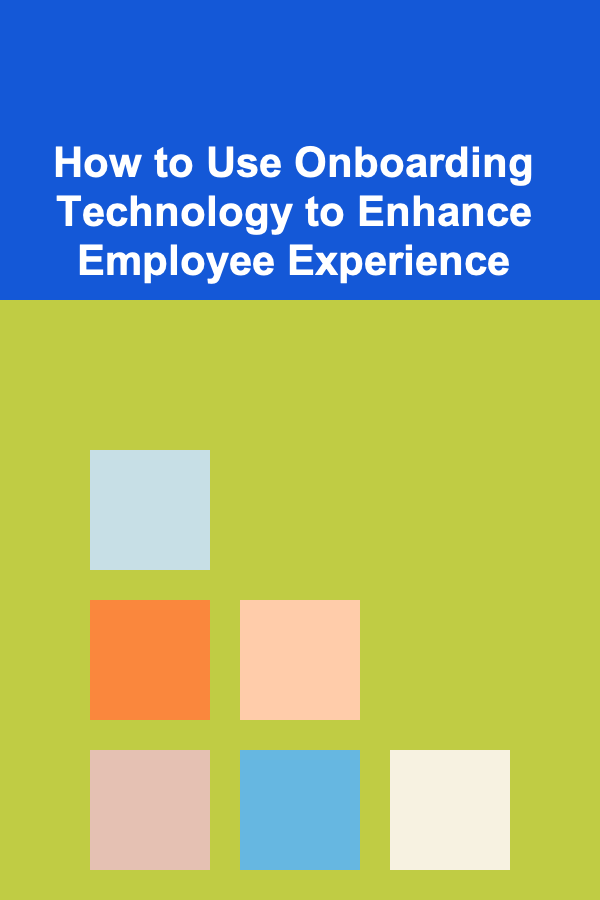
How to Use Onboarding Technology to Enhance Employee Experience
ebook include PDF & Audio bundle (Micro Guide)
$12.99$6.99
Limited Time Offer! Order within the next:

Onboarding is a critical part of the employee lifecycle, setting the tone for an employee's entire journey within a company. It's the first chance to truly engage new hires and help them understand their role, the company culture, and how they can succeed within the organization. However, traditional onboarding processes can often feel overwhelming, disorganized, and disconnected from the employee's long-term goals. This is where onboarding technology comes into play.
In recent years, organizations have increasingly adopted onboarding technology to streamline and enhance the employee experience. Leveraging the right tech tools can not only simplify the onboarding process but can also build a stronger connection between the company and its new hires, improve productivity, and ultimately lead to better retention rates.
This guide will explore how to effectively use onboarding technology to enhance the employee experience.
Streamlining the Onboarding Process
The first and most obvious benefit of onboarding technology is the ability to streamline and automate various aspects of the process. Traditional onboarding often involves a great deal of paperwork, manual tasks, and administrative burden. With onboarding software, many of these tasks can be automated, reducing the chances of human error and saving both time and effort for HR teams and employees alike.
a. Automated Paperwork and Documentation
Onboarding technology allows new hires to complete and submit necessary paperwork (such as tax forms, benefits enrollment, confidentiality agreements, and direct deposit forms) electronically before they even step into the office. This eliminates the need for employees to deal with paper forms or spend time on administrative tasks, making the process quicker and more efficient.
By using digital platforms, employers can also store these documents in secure cloud-based systems, ensuring compliance with data privacy laws and making it easy to retrieve them in the future.
b. Customizable Workflows
Onboarding software enables HR teams to create customizable workflows that guide new employees through each step of the process. These workflows can be designed to include training materials, essential company policies, team introductions, and even first-day meetings, providing a clear and structured experience from day one. With automated reminders and notifications, employees will know exactly what they need to do and when, reducing confusion and stress.
c. Self-Service Portals
Onboarding technology often includes self-service portals where employees can access information about the company, their benefits, training modules, and other essential resources. This not only empowers employees but also alleviates HR teams from answering repetitive questions, allowing them to focus on more strategic activities.
Personalizing the Onboarding Experience
Each employee is unique, and the more personalized the onboarding process, the more likely employees are to feel engaged and valued. Onboarding technology can help create a tailored experience that speaks to each new hire's needs, role, and goals.
a. Tailored Training Programs
One of the most powerful features of onboarding technology is the ability to customize training programs based on an employee's role, department, or skill set. New hires can be assigned specific training modules that are relevant to their responsibilities, ensuring they start with the most critical knowledge and skills.
For example, a software developer might have a different training path compared to someone in sales or customer service. Onboarding technology allows these distinctions to be easily incorporated into the employee's journey, improving learning outcomes and productivity.
b. Role-Specific Information
Beyond training, onboarding platforms can offer employees access to role-specific content, such as company manuals, product documentation, and other resources. Personalized content tailored to their department or team can help them get up to speed quickly, rather than feeling overwhelmed by a one-size-fits-all onboarding approach.
c. Interactive and Engaging Content
To make the experience more engaging, many onboarding platforms now offer interactive content, such as quizzes, gamified tasks, or videos. These elements keep new hires engaged while they learn about the company culture, policies, and job-specific responsibilities. Interactive onboarding content can make employees feel more involved in the process and less like passive participants.
Enhancing Company Culture and Engagement
The onboarding process is the first opportunity to immerse new employees in the company culture. Onboarding technology can help create a strong sense of belonging and connection right from the start.
a. Welcome Videos and Messages
Using onboarding platforms, companies can provide personalized welcome videos or messages from leadership, department heads, or future coworkers. This helps new employees feel like they're already a part of the team before even walking into the office.
Additionally, some platforms can introduce employees to the company's mission, values, and cultural norms through engaging videos or interactive learning modules. By showcasing what makes the company unique, new hires can better understand the company's purpose and how they fit into the larger organizational vision.
b. Virtual Meet-and-Greets
Technology can also enhance the social aspects of onboarding. Virtual meet-and-greets, team introductions, and live Q&A sessions can be scheduled through the onboarding platform, allowing employees to meet their coworkers and ask questions before they start working on projects. These interactions are especially beneficial for remote employees who may not have the chance to interact with their colleagues in person.
c. Mentorship and Buddy Programs
Another key component of successful onboarding is connecting new hires with a mentor or buddy. Onboarding technology can facilitate this by automatically matching new employees with appropriate team members who can guide them through their first few weeks. This personalized connection helps employees feel supported and integrated into the team, which is especially crucial for remote or hybrid teams.
Boosting Productivity with Early Access to Tools and Resources
Onboarding technology can help new employees get started quickly by providing them with early access to the tools, software, and resources they'll need to be productive in their roles.
a. Pre-boarding Activities
By using onboarding technology, companies can allow new employees to complete essential pre-boarding activities such as setting up their accounts for internal systems, reviewing key documentation, and receiving relevant materials before their official first day. This allows new hires to hit the ground running on their first day, without wasting time on administrative tasks.
b. Access to Knowledge Base and Resources
Onboarding platforms often feature a centralized knowledge base where employees can access helpful resources, including company policies, training videos, FAQs, and contact information for HR. Having this information at their fingertips allows employees to solve problems independently and reduces the dependency on HR or team leaders for guidance.
c. Software and Tool Training
Many onboarding platforms also offer specific software training, helping employees familiarize themselves with the tools they'll be using on a daily basis. By offering tutorials and hands-on practice, technology can ensure that employees are comfortable and competent using the tools necessary for their work.
Gathering Feedback and Measuring Success
Onboarding doesn't end after the first week or month. To continuously improve the process and ensure that employees feel supported throughout their journey, it's crucial to gather feedback and measure the effectiveness of the onboarding experience.
a. Surveys and Feedback Tools
Most onboarding platforms have built-in feedback mechanisms, such as surveys, that allow new employees to rate their onboarding experience. By collecting feedback on various aspects of the process---from training content to engagement and communication---companies can identify areas of improvement and make adjustments for future new hires.
b. Tracking Progress
Onboarding technology also allows companies to track the progress of new hires through different training modules and milestones. This helps HR teams and managers understand whether employees are engaging with the content and reaching key development goals. Real-time analytics can inform decisions about whether additional support or training is needed to ensure the new hire's success.
Conclusion
Onboarding is much more than just a series of administrative tasks---it's an opportunity to set the tone for an employee's entire experience at the company. By leveraging onboarding technology, businesses can transform the traditional, often cumbersome process into a streamlined, engaging, and personalized experience that benefits both the company and the employee.
Through automation, customization, and enhanced engagement, onboarding technology can significantly enhance the employee experience, improve productivity, and drive long-term retention. Whether you're looking to save time, build a stronger company culture, or empower employees from day one, onboarding technology is an invaluable tool that can make a real difference.
Reading More From Our Other Websites
- [Reading Habit Tip 101] The 10-Minute Daily Routine That Guarantees You'll Finish Every Book
- [Home Security 101] How to Use Smart Sensors to Detect Unusual Movements in Your Home
- [Organization Tip 101] How to Set Up a System for Tracking Household Chores
- [Home Family Activity 101] How to Turn Chores into Family Games and Encourage Teamwork
- [Mindful Eating Tip 101] Best Mindful Eating for Busy Professionals -- Quick Tips & Techniques
- [Organization Tip 101] How to Use Minimalism to Simplify Your Study Room
- [Home Lighting 101] How to Select the Best Bathroom Lighting Fixtures for Every Room
- [Biking 101] The Ultimate Guide to Cycling Routes: How to Plan the Perfect Ride
- [Home Space Saving 101] How to Use Stackable Furniture for Better Space Management
- [Organization Tip 101] How to Utilize Breaks for Better Focus and Productivity

How to Enhance Your Kitchen with Smart Storage Ideas
Read More
How to Keep Track of Assignments and Due Dates Effectively
Read More
How to Make Family Cooking Time Enjoyable for Everyone
Read More
How to Set Up a Checklist for GDPR and Privacy Compliance in Email Campaigns
Read More
How to Track Non-Cash Donations: A Charitable Giving Guide
Read More10 Tips for Automating Your Fixed Expenses Tracking
Read MoreOther Products

How to Enhance Your Kitchen with Smart Storage Ideas
Read More
How to Keep Track of Assignments and Due Dates Effectively
Read More
How to Make Family Cooking Time Enjoyable for Everyone
Read More
How to Set Up a Checklist for GDPR and Privacy Compliance in Email Campaigns
Read More